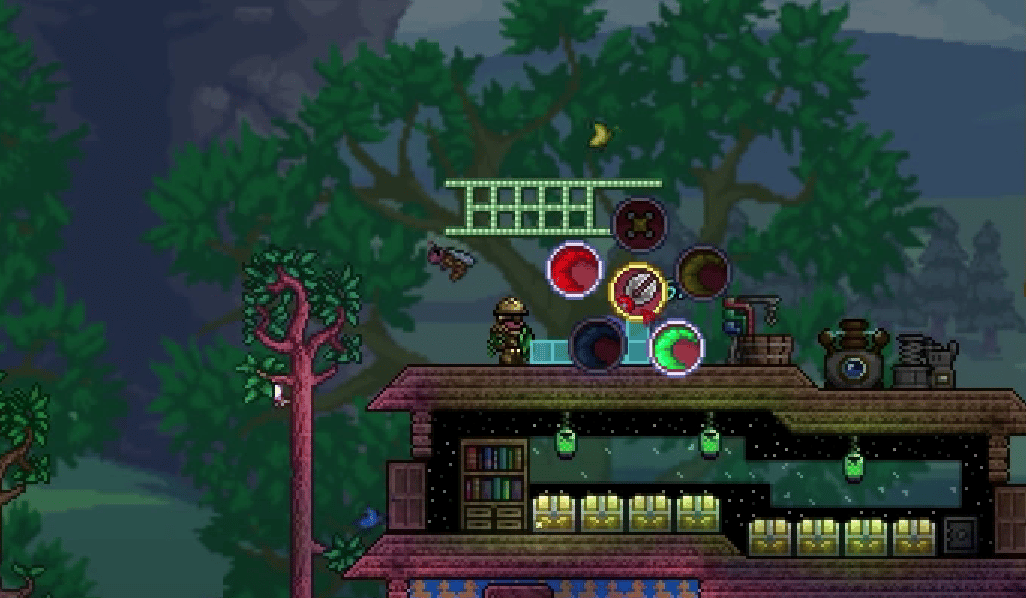We are often asked how to get rid of Crimson in Terraria. This evil biome spreads to nearby blocks, turning them into appropriate Crimson tiles. This also changes the appearance of the area, bringing forth new, deadly opponents.
The worst thing about this biome is that it can prevent you from finishing the game. As it spreads around, infecting nearby blocks, it also eliminates nearby flora and fauna. The biome-specific bosses can no longer appear on the map, as well. Aside from stifling your progression, it will also prevent certain loot from dropping.
What are corrupting biomes?
Corrupting or evil biomes is a joint name for Crimson, Corruption, and Hallow. These three environments spread around the map, devouring previously existing biomes. It is worth noting that the Harmode exclusive Hallow is slightly less aggressive than its counterparts, although it can still cause issues.
Upon starting a new game, a specific seed is allocated to a map. According to this seed, you’ll play in a Crimson or Corruption world. There’s a 50% chance for either one of them to appear. Hallow, on the other hand, always appears when you start Hardmode.
In many ways, these infectious environments are interchangeable. Although they provide different enemies and loot, they work in basically the same manner. During pre-Hardmode, they spread their influence on grass and bushes. When you reach Hardmode, they can convert just about everything on the map, including underground blocks.
What are evil biomes?
It doesn’t take much to differentiate Crimson, Hallow, and Corruption from other regions. Crimson is easily noticeable by its blood-red background, red grass and leaves. In many ways, it reminds us of autumn. Corruption is a bit more ominous, focusing on purple color and dead trees.
Aside from color schemes and visual design, evil biomes are characterized by music. As you can presume, it’s completely different from other themes, bringing gloom to the game. Like the Corruption biome, this section of the map features numerous chasms, Crimson Altars and Hearts.
This region features some tough monsters such as Blood Crawlers, Face Monsters, Herplings, Blood Jelly, and Blood Feeder. The area’s boss is Brain of Cthulhu, which, unlike its Corruption Counterpart Eater of Worlds, doesn’t have a mechanical version.
The negative impact of Crimson
As strange as this might sound, one of the main goals of Terraria is stopping the spread of evil biomes. This infectious environment is more likely to ruin your experience than some top-tier bosses. Not only do Crimson and Corruption stifle your progression, but they can also be very annoying.
Here’s how it affects your game:
- Like other evil regions, it can overtake the Jungle, preventing you from finishing the game.
- If these „bad“ blocks start spreading to your houses, they’ll no longer be inhabitable. In other words, you won’t have access to NPCs. Without vendors and certain game features, you’ll have a hard time finishing the playthrough.
- Removal of certain monsters and bosses will prevent you from getting unique tools, weapons, and materials.
- Monsters that live in this region are much harder to beat and tend to be more aggressive. Furthermore, they spawn in large numbers. They’re especially troublesome during events, making the enemy waves that much harder.
The biggest issue that comes with the spread of Crimson is boredom. You’ll have to focus all your attention on these hyperactive opponents while not being able to sell the stuff or craft items.
How does Crimson Spread?
Crimson and Corruption follow the same rules when it comes to their spread:
- This biome can turn any blocks into their Crimson counterpart as long as they’re within three to six tiles. Those that are within three tiles are much more susceptible to conversion.
- At first, the infection isn’t that noticeable. It can only affect the surface during pre-Hardmode, so digging small ditches on the edges of the biome can easily prevent its spread.
- Things get much trickier during Hardmode. The infection can spread to just about any tiles, whether they’re on the surface or underground. Ideally, you shouldn’t start Hardmode before putting in place protective measures.
- Aside from affecting all tiles, the infection becomes faster during Hardmode, spreading at twice the speed. After every game tick, a certain number of blocks on the map will turn to their Crimson counterpart. The spread speed returns to normal after you kill Plantera. To minimize the impact of the evil biome, we recommend that you rush Plantera.
- In most cases, Crimson spreads to other biomes on the surface. In fact, surface conversion is six times faster than underground spread, so this is the area where you’ll have to pay the closest attention.
- Thorns are common obstacles that appear on the surface and are a good indication of Corruption or Crimson. They slow you down as you’re running around dealing damage to the character. Thorns can spread to a nearby surface that is up to four tiles away.
- For the most part, infection is predictable, and you can introduce nice measures to prevent its spread. However, the trouble starts as you start destroying Crimson Altars. Their destruction generates new ores on the map but also randomly converts tiles into evil counterparts. As the spawning is randomized, they can start consuming whole biomes without you realizing it.
- Another interesting thing about infectious areas is that they can introduce new enemies depending on the biome they converted.
How to get rid of Crimson in Terraria?
The spread of infectious tiles isn’t that relevant during pre-Hardmode. All you need to do is dig holes around the troublesome biome, and you can enjoy your adventure. As you’ll have enough time during this phase, it’s recommended that you start introducing measures that will help you transition into Hardmode.
Prevent spread to the base
For many reasons, you have to prevent Crimson from spreading to your base.
Most players like to address this issue by building their houses in the air. As long as they’re six tiles above the ground, the infection can never touch them. Otherwise, if these tiles spread around the base, your NPCs will no longer spawn. Among others, this will prevent the appearance of Steampunker, who sells Clentaminator, a powerful anti-infection tool.
Although an excellent solution, it can cause a few problems initially. For example, climbing up and down the rope or ladders to reach the stash and crafting station is annoying. Things get better later on when you have enough materials to make a Bed and change your spawning location.
Although a bit riskier, you can leave your base on the ground and build a moat around it. The tunnel should be six tiles wide encircling houses from all sides. If you wish to feel even more secure, you can place Hallow blocks on the outside, as Crimson cannot pass through these tiles.
Unlike an air-suspended castle, this kind of approach can lead to some issues. For example, the ground beneath the structure can still change into Crimson when you start destroying altars. If you’re using Hallow blocks for insulation, this can cause Hallow-specific monsters to appear, which can be a nuisance.
Splitting the map
A fantastic way to approach the issue is by splitting the map into segments.
First off, start by creating a Hellavator (a hole that goes all the way to the bottom) on both sides of the evil biome. This will prevent the blocks from spreading sideways. You might also wish to consider isolating Jungle because this area of the map is necessary for your Hardmode progression.
You can also create two Hellavators on the sides of your base for some extra security. After you’ve done that, start creating horizontal tunnels. That way, you can segment that map into numerous smaller cubes. If the infection appears in one of them, it’ll be much easier to contain them.
Consider adding Minecarts alongside horizontal lines. Not only will this make mining and traveling easier, but it will help you remove Crimson spread within contained areas. Splitting the map is the surefire way of addressing the problem. However, you might still experience a nasty surprise after destroying altars.
Solutions and Clentaminator
Steampunker is an NPC that sells different anti-infection tools and materials. Most notably, he sells Clentaminator and Green Solution.
Clentaminator works like a ranged weapon. It has a range of 60 units, spraying everything in its path. The tool also affects two tiles behind the character. You use it in conjunction with different solutions, turning tiles into Crimson, Hallow, or Corruption biomes or restoring them to their previous state.
Out of these five ammo types, Green Solution is used for converting tiles to their original form. With enough units, you can hypothetically eliminate all evil blocks from the game. However, as Green Solution is too expensive, most players use this tool strategically to purify a certain area or base.
Despite being a powerful tool, Clentaminator has a few issues. First and foremost, it’s much better suited for surface removal than for underground conversion. Having numerous Hellevators and mine shafts can definitely help, but you might not be able to reach certain Crimson tiles. Secondly, the solutions are extremely expensive.
Green Solution works like any ammunition type by placing it in appropriate slots. You should still be careful when using Clentaminator nonetheless. If you also have Red and Purple Solutions in your ammo inventory, you might inadvertently spread evil blocks.




